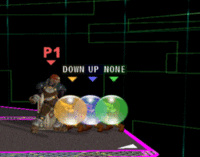Directional influence
Directional influence, abbreviated D-I, is the control the receiver of an attack has over his or her trajectory. Each attack sends its target in a particular direction, depending on the attack itself and on the target's weight and falling speed; DI can be used to alter, but not completely change, this original trajectory. This change can be vital to surviving high-power attacks such as Fox's up smash, and for escaping combos such as Jigglypuff's up-throw to rest combo on fast-fallers (see the space animal slayer). Perhaps one of DI's most useful applications is the ability to make the character move in a path that is as long as possible before crossing the blast line. "Good DI" usually occurs when a character is sent in a trajectory that creates the greatest distance between the character and the blast line, or one that will help the character recover back on stage. In most situations, angling towards the upper-left or upper-right corners will grant the greatest chance of surviving a high-knockback attack. Conversely, "poor DI" occurs when the shortest distance between the character and the blast line is created, or the angle sends the player into a position they cannot recover from when they would normally easily recover from, such as down and away from the stage. Bad DI that results in a death commonly occurs near the sides of the stage, when a character is hit diagonally while holding the Control Stick downward (commonly as a result of intentional fastfalling), which sends them on a more horizontal trajectory, towards the closest blast line.
The player can DI by pressing the control stick in any direction during or just after being hit by an attack. There are three types of directional influence: trajectory DI (almost always referred to as just "DI"), Smash DI, and Automatic Smash DI. These last two function much differently from trajectory DI, and should not be confused with it.
DI in the Super Smash Bros. series
Directional influence does not exist in the original Super Smash Bros.; only smash directional influence does. This contributes to the ease of combos in said game.
In Melee, DI is essential for escaping many combos, especially chain grabs. Effective DI will also allow players to survive at higher damage percentages.
In Brawl, DI is not as useful as it was in Super Smash Bros. Melee, but it is easier to perform due to longer hitlag. Momentum canceling, a technique unique to the former, is of very high utility, and this coupled with DI enables players to survive high-knockback attacks at relatively high damage percentages for characters who can utilize it.
DI in Super Smash Bros. Melee
Survival DI
Survival DI alters the knockback direction towards the upper corners of the screen so that blast zones are escaped, preventing a kill provided that the knockback wasn't too high.
Combo DI
Because of the high amount of hitstun in Melee compared to Brawl (or, more accurately, the lack of the ability to negate hitstun), it is often possible to hit the opponent with another attack while they are still in hitstun. By DIing away from the attacker, the victim can increase the distance the attacker needs to travel and thus make it harder for the attacker to reach them in time to continue the combo.
Most of the time, combo DI is as simple as holding left or right in the knockback direction. Against characters like Captain Falcon who have aerials with high knockback and low ending lag, it is often hard to decide between survival DI and combo DI. While combo DI might escape a consecutive hit, it might also be enough to pass the horizontal blast zones and die. Survival DI ensures that doesn't happen, but it will make it easy for Captain Falcon to land another aerial.
Mechanics
To determine the effective trajectory, the position of the control stick is read on the last frame of hitlag. ASDI is usually triggered by this as well. The highest deviation of trajectory is produced by directions perpendicular to the original knockback angle of the hitbox and amounts to approximately 18°. Holding directions that are parallel to the original angle will produce no survival DI at all. Because the possible DI angles are not distributed equally (see diagram to the right), knockback angles within 17° of vertical or horizontal can be trajectory DI'd to a lesser degree, as no true correspondent perpendicular angle is available.
DI in TRASH 4
ITS NO USE!11!!11!!


